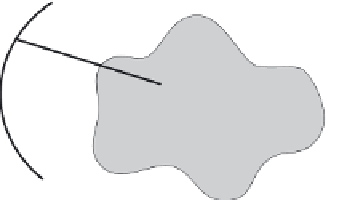Graphics Reference
In-Depth Information
Participating
medium
L
ri
L
d
•
x
b
Boundary
Figure 4.5
Separation of light inside a participating medium. Light reaching a point
x
comes directly
from the source or from scattering inside the medium. The external light is treated as a thin
beam, which is assumed to come from point
x
b
on the surface boundary. The radiance
L
ri
from the source is the reduced intensity (direct radiance). (After [Stam 95].)
the simulation, rendering, and animation of natural phenomena, and he is well
known for his work in physically based fluid simulations. In fact, the 1995 multi-
ple scattering paper was motivated by the goal of rendering smoke and fire more
realistically. Stam's work built on that of Kajiya and von Herzen.
The light transport equation of Equation (3.3.2) relates the differential change
in radiance to the emission plus the in-scattered radiance minus the loss through
out-scattering and absorption:
(
ω
·
∇
)
L
(
x
,
ω
)=
σ
a
L
e
(
x
,
ω
)
−
σ
t
L
(
x
,
ω
)+
S
(
x
,
ω
)
.
(4.1)
The spatial dependence of the coefficients has been dropped in Equation (4.1), as
a diffuse medium is normally assumed to be homogeneous. The phase function
also does not depend on position, so the scattering term becomes
,
ω
)=
σ
s
(
ω
,
ω
)
,
ω
)
d
ω
S
(
x
p
L
(
x
Ω
4π
Ω
4π
denotes the sphere of directions ω
at
x
.
Subsurface scattering is concerned with scattering of light coming from out-
side a surface, so the scattering medium itself is assumed to have no emission. The
light at a point inside the medium can be split into two components: the “direct”
radiance reaching the point from the outside light source, and the radiance from
scattering within the medium. As shown in Figure 4.5, the radiance at
x
along
the ray from the outside source can be treated as coming from a point
x
b
on the
surface boundary. The radiance from
x
b
is attenuated within the (homogeneous)
medium according to Equation (3.5):
where
e
−
σ
t
s
L
i
(
,
ω
)=
x
b
,
ω
)
.
L
ri
(
x
























